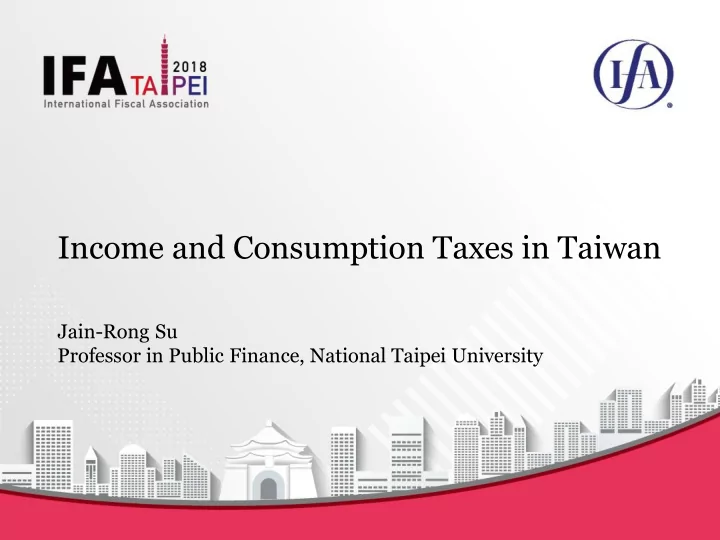

Income and Consumption Taxes in Taiwan Jain-Rong Su Professor in Public Finance, National Taipei University
Presentation Outline Overview of tax trends Recent Consumption Tax Reforms in Taiwan Recent Income Tax Reforms in Taiwan Concluding Remarks 2
Overview of tax trends Breakdown of OECD tax revenue-average PIT SSCs CIT Property Comsuption taxes Other taxes 2007 2014 Personal Personal income taxes income taxes Consumption Consumption 23.7% 24.0% taxes taxes 32.6% 31.8% 24.7% 26.2% Corporation Corporation income taxes income taxes 11.2% 8.8% Source : OECD Revenue Statistics 3
Overview of tax trends Breakdown of OECD tax revenue-average Tax Structure in OECD Countries (1980-2015) 60.00 % of Tatal Tax Revenue w/o SSCs 50.00 40.00 Personal 30.00 income taxes 24.0% 20.00 10.00 0.00 1980 1985 1990 1995 2000 2005 2010 2015 Income Tax Consumption Tax Property Tax and Others Source : OECD Revenue Statistics 4
Overview of tax trends Evolution of the average statutory CIT rates and CIT revenues in the OECD CIT revenue Statutory CIT rates (% of GDP) (%) 23.3% 5 Source : OECD Tax Policy Reforms 2017
Overview of tax trends Evolution of the average standard VAT rate in the OECD VAT rates (%) 23.3% 6 Source : OECD Tax Policy Reforms 2017
Overview of tax trends • Many countries have recently amended their tax rules on cross- border sales of services and intangibles • Many countries have recently aligned tax reforms on new taxes on the environment and health (such as tobacco, sugar-sweetened beverages, and transport fuel) 7
Overview of Tax System in Taiwan • The income tax and business tax (VAT) are the two main tax items, which account for 43.8% and 17.1% of total tax revenue in 2017. • The profit-seeking enterprise income tax rate is 20% and slightly lower than the average tax rate of 23.32% of OECD countries. • The VAT tax rate is 5%, which is the lowest among the developed countries implementing VAT. 8
as % of Total Tax Revenue w/o SSCs Overview of Tax System in Taiwan 10 20 30 40 50 60 70 0 1980 1981 1982 1983 1984 1985 Income Tax 1986 1987 1988 Tax Structure in Taiwan (1980-2017) 1989 1990 1991 1992 1993 Consumption Tax 1994 1995 1996 1997 1998 1999 2000 2001 2002 2003 2004 Property Tax 2005 2006 2007 2008 2009 2010 2011 2012 2013 2014 2015 14.64 37.38 47.99 2016 2017 9
Recent Consumption Tax Reforms in Taiwan 1. VAT on cross-border sales of electronic service by foreign suppliers - According to the VAT Act, starting from May 1, 2017, foreign companies selling cross-border electronic services to domestic individual consumers in Taiwan shall register and pay VAT. - Till now, 76 foreign companies have registered. 2. Provide three years of tax incentive measures to promote mobile payment - In order to promote mobile payment, a preferential business tax rate at 1% is offered to small businesses selling goods or services without using uniform invoices and accepting mobile devices payment. 10
Recent Income Tax Reforms in Taiwan 1. Income Tax Reform from 2018 - To raise the amount of four deduction items in individual income tax - To reduce the highest marginal individual income tax rate from 45% to 40%. - To abolish the partial imputation tax system on dividends and adopt a new dividend tax regime - To raise the tax rate on the profit-seeking enterprise income from 17% to 20% - To reduce the surtax rate on corporate retained earnings from 10% to 5% 11
Recent Income Tax Reforms in Taiwan 2. Income tax on cross-border sales of electronic service by foreign suppliers - We issued a new income tax interpretive rule on January 2, 2018, which requires foreign suppliers selling cross-border electronic services to domestic purchasers and having income from sources in Taiwan to pay income tax. - The income tax regime provides clear and simplified rules for the calculation of income derived from sources in Taiwan 3. Anti-tax avoidance measures The anti-tax avoidance measures we have adopted recently are as follows: - Controlled Foreign Company (CFC) Rule - Place of Effective Management (PEM) Rule - Three-tiered Transfer Pricing Documentation (TP) 12
Recent Income Tax Reforms in Taiwan 4. Increase international information transparency - We established an information exchange mechanism for tax purposes in line with the new international standard on information transparency. - It will enhance the benefit of international tax cooperation, increase the efficiency of investigation on international tax avoidance cases, maintain tax fairness, and protect our tax revenue. 13
Concluding Remarks 1. Similar Tax Structure to OECD Average 100% Property 4.6 4.7 13.6 13.5 taxes 14.6 14.2 15.6 16.6 19.6 23.6 80% Consumption 32.7 22.3 taxes 44.2 27.4 33.8 37.5 37.3 40.4 38.1 60% 39.1 40% Income taxes 64.2 62.6 55.9 52.0 51.2 48.1 48.9 44.0 42.3 20% 37.4 0% R.O.C. R.O.C. Korea France United Germany Japan Canada United Denmark (2017) (2016) Kingdom States Source : OECD Revenue Statistics Note: R.O.C. personal income tax includes the land value increment tax. 14
Concluding Remarks 2.The Lowest Tax Burden among Advanced Economies United Country R.O.C. Korea France Germany Japan Singapore States (Year) (2016) (2016) (2016) (2016) (2015) (2016) (2016) (Without 13% 19.4% 28.5% 23.4% 18.6% 19.8% 14.1% social security contributions) Source : OECD Revenue Statistics In response to the development of new forms of internet transactions, changes in population structure, as well as environmental and health policies, Taiwan will continue to refer to trends in international taxation reforms and adjust its tax system taking into account tax justice, economic efficiency, simplification of tax administration, and fiscal revenue. 15
Concluding Remarks 3. Structural Reforms - Issues • Broadening the Tax Bases (the scale of underground economy is about 25% of GDP) • Increasing the Revenue Share form Consumption Tax (from 30s% to 40s%) • Green Tax in lieu of Commodity Tax - Challenges • Feasibility for Political Agenda • Supportiveness to Economic Development • Adequacy for Revenue Requirement • Trade Off between Fairness and Simplification 16
Thank you for your attention
Recommend
More recommend